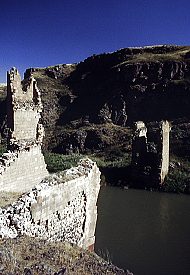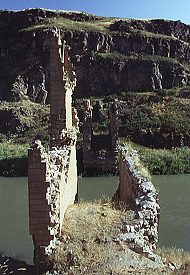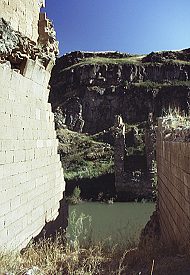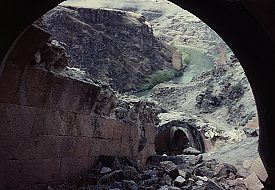Structure: Marr-Orbeli site 96.
History
This bridge over the Akhurian/Arpa river may date from the Bagratid period (i.e. from tenth or the eleventh century). Alternatively, it may date from the thirteenth century. An inscription found nearby stated that building work was done on the approach to the bridge in the early fourteenth century.
The bridge's single arch (which spanned over 30 metres) has fallen, leaving only tall abutments that were perhaps part of a fortified gate. Nineteenth century travellers reported a guardhouse next to the bridge, but this has now vanished. The drawing below is from the 1850s.
Seen from this bridge, the opposite (Armenian) side of the river is tantalisingly close - yet completely inaccessible. The broken arch of the bridge becomes extremely symbolic given Ani's current situation - a city cut off from the country of its creators. Some sources mention that there had been a second bridge over the Akhurian, below the Kizkale promontory. Nothing much, if anything, remains of it. |
|
 4. Close... |  5. Closer... |  6. Closest you can get to Armenia |
Nearby StructuresStructure: Marr-Orbeli sites 88 and 89.
Bordering the enclosure wall of the Monastery of the Virgins is a long and spacious covered stairway with a vaulted roof, partly cut into the natural rock.
It leads down to the Akhurian river (and not into the monastery as stated in some books), and probably contained a roadway leading to the bridge over the river. Its covered construction may have been designed to further separate the outside world from the monastery which was already situated in an isolated part of the city. In the valley below the Monastery of the Virgins are various structures. These include a tiny, single naved chapel (site 88), and a rectangular structure (site 89) that may have been a watchtower to control movement along the river bank. (Under current Turkish restrictions, visitors to Ani cannot visit the ruins of the bridge or descend to the river. In the early 1990s, just after the collapse of the Soviet Union, it was possible to swim in the river; now the whole area is off-limits.) |
 7. The covered stairway with the ruins of the bridge over the Akhurian visible in the distance
|